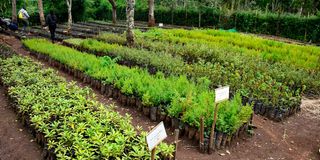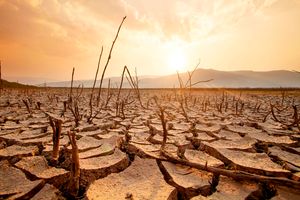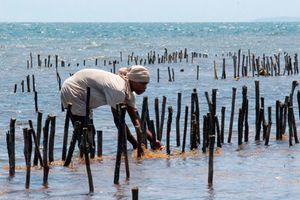
Geta Forest Nursery in the Aberdare ecosystem.
Across the globe, land and seascapes are the foundation of life. They regulate our climate, provide food and water, store carbon, and sustain biodiversity. They are also the beating heart of our cultures, economies, and communities and when they are degraded, we are diminished both in the health of our environment and in the possibilities, we hold for generations to come.
This week, the African Union (AU) brought together experts and partners in Addis Ababa for a landmark meeting to advance the Great Green Wall Initiative (GGWI) - one of the most ambitious land restoration efforts undertaken on the continent. Though this meeting may have not dominated headlines, its importance to Africa, and indeed the world, cannot be overstated.
The GGWI is an ‘African-led dream’ to combat desertification across the Sahel region. Launched by the AU in 2007, the initiative envisions a mosaic of trees, vegetation, and restored land stretching 8,000 kilometres from Senegal in the west to Djibouti in the east.
African leaders, scientists, civil society, and development partners gathered to translate this vision into action, guided by a new GGWI Strategy and Implementation Framework (2024–2034). Crucially, it also recognized the direct link between restoration and peacebuilding, especially in the fragile Sahel, where insecurity and climate risks are deeply interconnected.
2030 restoration goal
By 2030, the initiative aims to restore 100 million hectares of degraded land, sequester 250 million tonnes of carbon, create 10 million green jobs, and improve food security for more than 20 million people. Over time the GGWI has become more comprehensive in its geographical reach extending beyond the 11 original member countries to embrace a more continent wide approach with new members.
So far, the GGWI has restored over 30 million hectares and created 3 million jobs. In Niger, the once-barren Simiri Plateau now thrives with vegetation. In Ethiopia, over 1 million hectares have been restored across three regions. But despite these inspiring examples, the initiative has only achieved about 30 percent of its 2030 restoration goal.
Funding has been a major bottleneck and conflict across the Sahel has further undermined progress. Without peace and stability, restoration efforts become nearly impossible, as communities focus on survival over sustainability. Yet, these obstacles also highlight the critical need for integrated approaches that address both environmental degradation and socio-political instability.
The GGWI has captured the imagination of those who understand that the climate crisis cannot be solved by machines alone — it must be solved by people, and particularly by those who live closest to the land. In places like Niger and Ethiopia, we are already seeing green shoots emerge where the soil had once given up. These are more than ecological successes; they are testaments to African ingenuity and perseverance. That is why the work of the AU is so vital. This week’s meeting was a step forward, laying the foundation for a decade of action through improved coordination, stronger partnerships, and most importantly, putting communities at the centre of the work.
Because it is people — not plans — who will restore Africa’s landscapes. It is women leading local cooperatives, elders passing on traditional knowledge, and young people innovating new ways to nurture the land. It is those closest to the soil who must lead, and those furthest from it who must support.
Africa’s restoration movement
At the World Resources Institute, we are proud to stand with African countries through initiatives like Restore Local and AFR100, a continental effort that forms the framework of initiatives like the Great Green Wall. We believe that restoring land is not just good for the planet — it is essential for economic revival, social stability, and cultural renewal.
What gives me the most hope is that the momentum is real. From Dakar to Djibouti, there is a groundswell of local energy and global solidarity behind Africa’s restoration movement. Young Africans, in particular, are rising with purpose creating a movement anchored in restoration economies.
We are also at a powerful moment globally. With the International Day for Biological Diversity around the corner, we are reminded that the health of our ecosystems underpins everything. There is no biodiversity without restored land. No climate solution without resilient ecosystems. No justice without dignity for those whose lives depend most directly on nature.
The Great Green Wall is a living symbol of what is possible when vision, leadership, and community come together. It is a reminder that the answers to our most urgent global challenges may not lie in distant boardrooms or foreign capitals, but in the hands of a farmer planting the first seedling in degraded land.
Ms Mathai is the MD for Africa & Global Partnerships at the World Resources Institute and Chair of the Wangari Maathai Foundation







